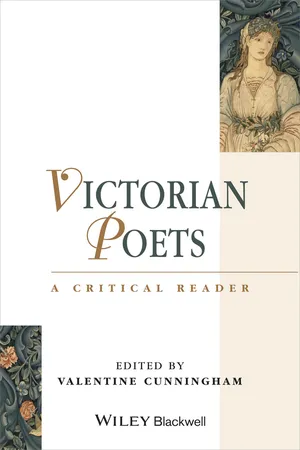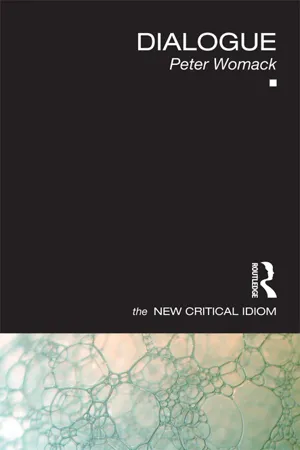Dramatic Monologue
A dramatic monologue is a type of poem in which a single character speaks to a silent listener, revealing their thoughts and feelings. The speaker often addresses a specific situation or audience, providing insight into their personality and motivations. This form of poetry allows for a deep exploration of the speaker's inner world and can create a sense of intimacy and immediacy for the reader.
5 Key excerpts on "Dramatic Monologue"
- eBook - ePub
New Playwriting Strategies
Language and Media in the 21st Century
- Paul Castagno(Author)
- 2012(Publication Date)
- Routledge(Publisher)
...The convention in which intense character emotions trigger the articulation of carefully composed language is at the heart of the contrivance. Most monologues use selective repetition and figures of speech, as well as negative space—clarified through pauses, silences, or ellipses. The monologue is composed, orchestrated for effect, and marked by a heightened, often formal level of language. Often used to establish the “reality of the character,” monologue may theatricalize what Dorrit Cohn has described as the transparent mind, allowing audiences entry into the characters’ consciousness: their motivations, history, or point of view. As Cohn posits: If the real world becomes fiction only by revealing the hidden side of human beings, the reverse is equally true: the most real, the ‘roundest’ characters of fiction are those we know most intimately, precisely in ways we could never know people in real life. (Cohn 1978, 5) This psychological “rounding” provided by monologue serves to texture the dramatized action. The Aristotelian action expands to include the articulation of thought processes, emotional states, visual metaphors, and so on. Who can think of William Shakespeare’s greatest play, Hamlet, bereft of the soliloquies? Before a live audience, heightened by lighting and staging effects supporting the force of the actor, the monologue’s impact can be powerful. The theatricalized baring of the one before the many rivets an audience’s attention to this character’s inner struggles, moment of epiphany or intimate revelation. This convention of monologue remains one of the most tried and true elements of dramaturgy, and its effectiveness is reserved for the stage. Because of their essentially visual, image-oriented basis, neither film nor television suffer long speeches gladly. In film, monologue is invariably formatted as a voice-over: a vocal narrative track that underscores a series of visual images...
- Rust Hills(Author)
- 2000(Publication Date)
- Mariner Books(Publisher)
...There is the direct monologue, where the reader is being addressed directly. Then there is the Dramatic Monologue, in which a listener is supposedly or “actually” somehow there, between the monologist and the reader—an uneasy state of existence, to say the best of it. And there is the interior monologue, in which the narrator is not speaking aloud at all, but just somehow “thinking,” either in complete sentences or in a sort of Freudian free association of fragmented thoughts, the “stream of consciousness” method more or less invented by James Joyce for Molly Bloom’s “soliloquy” toward the end of Ulysses, and never used by anyone so well since, although it was once thought the method would revolutionize writing. As passages in novels, monologues can certainly sometimes be vehicles for fine writing, just as the soliloquy can sometimes be brought alive on the stage with heightened writing. But one reason the soliloquies in drama are sometimes so beautiful is that dramatists realize how awkward and unreal the convention is and hence produce their absolute best to cover over the artificiality of the occasion. Where the soliloquy is useful, though, or perhaps even necessary in the theater, in order to establish motivation or characterization, or whatever, it is never really necessary in fiction, where the reader can easily be made privy to a character’s thoughts or emotions in more straightforward, less “dramatic” ways. For a fiction writer to use the monologue form is to take up one of the playwright’s disadvantages for no necessary reason. As far as telling a whole short story in the monologue is concerned, the disadvantages are terrible. There’s the monotony of the single voice, for instance. Exposition’s difficult, especially in the interior monologue, where the character is in the ridiculous position of saying or thinking, aloud to himself in some way, things he perfectly well knows he knows already...
- eBook - ePub
Victorian Poets
A Critical Reader
- Valentine Cunningham, Valentine Cunningham(Authors)
- 2014(Publication Date)
- Wiley-Blackwell(Publisher)
...It represents modern character as a quotient, a ratio of history and desire, a function of the division of the modern mind against itself. Our apprehension of character as thus constituted is a Romantic affair; in Jerome Christensen’s apt phrase for the processing of the “lyrical drama” in Romanticism, it is a matter of learning to “read the differentials.” As a sampling of the dozens of poetry textbooks published in recent decades will confirm, the Dramatic Monologue is our genre of genres for training in how to read between the lines – a hackneyed but valuable phrase that deserves a fresh hearing. 8 In the reading of a Dramatic Monologue we do not so much scrutinize the ellipses and blank spaces of the text as we people those openings by attending to the overtones of the different discourses that flank them. Between the lines, we read in a no-man’s-land the notes whose intervals engender character. Perhaps the poet of the Dramatic Monologue gave a thought to the generic framing of his own art when he had the musician Abt Vogler (1864) marvel “That out of three sounds he frame, not a fourth sound, but a star” (l. 52). The quantum leap from text to fictive persona (the dramatic “star” of a monologue) is no less miraculous for being, like Abt Vogler’s structured improvisation, “framed,” defined and sustained as a put-up job. That such a process of character-construction tends to elude our received means of exegesis is a contributing cause for the depression of Browning’s stock among the New Critics. But one way to begin explicating a Dramatic Monologue in the Browning tradition is to identify a discursive shift, a moment at which either of the genre’s constitutive modes – historical line or punctual lyric spot – breaks into the other. III Since the premier writer of Dramatic Monologues was, as usual in such matters, the most ingenious, it is difficult to find uncomplicated instances in Browning that are also representative...
- eBook - ePub
- Glennis Byron(Author)
- 2014(Publication Date)
- Routledge(Publisher)
...Poets use the Dramatic Monologue to expose the conflicting and multiple positions through which the self can be situated and to emphasise the ways in which this self is produced by various socioeconomic and linguistic systems. In Carol Ann Duffy’s ‘Translating the English 1989’ (1990), for example, there is absolutely no attempt to create even the illusion of ‘character’: the speaker is clearly nothing more than the product of various conflicting discourses. ‘Welcome to my country!’ (1), the speaker begins, and then proceeds to list a confusing catalogue of what is on offer. ‘Daffodils (Wordsworth. Up North)’ (4), Shakespeare and the Opera are mixed in with wheel clamps, the black market and the football hooligan. ‘Also we can be talking crack, smack / and Carling Black Label if we are so inclined’ (11–12). Precisely because the various items are so incongruously brought together, and placed on an equal level, Duffy draws our attention to the way in which an acceptable version of English identity is more usually constructed through selectively eliminating some of the undesirable representations. Revisionist Dramatic Monologues The emphasis on questions of representation is particularly notable in contemporary revisionist monologues, monologues which draw upon characters from literature, history or myth in order to demonstrate how cultural beliefs and traditions have been fixed and formalised. Glyn Maxwell’s Out of the Rain (1992), for example, contains ‘The Thief on the Cross’ and a series of monologues entitled ‘The Beast and Beauty’, in which the Beast himself speaks. It is, however, women poets who most frequently use the monologue to engage in revisionary myth-making, and their monologues are often highly polemical. Since the late 1970s, many women have exploited the form of the monologue to give voices to those who were silenced or to subvert patriarchal representations of women...
...The charged silence in the middle of it, then, is a trace of the voices that have been silenced in the process of establishing its formal integrity. Drama is monologic not automatically (no use of language is monologic automatically), but because its coherence is sustained by the vigilant suppression of other voices which would cut across or complicate or dialogise it. It is ‘pure’ drama in the sense that its impurities are actively excluded: it is time to enquire what these might be. IMPURITIES OF THE THEATRE To recapitulate: pure drama consists of characters interacting in the medium of spoken dialogue while the dramatist, though omnipresent, is silent. From our account of this form, we can pick out four negative propositions which sustain Bakhtin's contention that drama is inherently monologic. (1) Not all staged verbal performances count as ‘drama’ in the strict sense. Some kinds of comic and popular theatre are half outside the category. Drama is wholly monologic only if it excludes these marginal elements. (2) In a play, each line of dialogue is intelligible as the verbal action of the individual character who utters it. Consequently, the dramatic word is single-voiced; double-voiced speech is impracticable. (3) Drama is primarily a representation of action, and the dialogue is subordinated to this project. Consequently, different speakers cannot represent different worlds, only different attitudes within the single world that is represented by the play as a whole. (4) Drama is the opposite of narrative: it is present as opposed to past, enacted as opposed to recounted, showing as opposed to telling...




